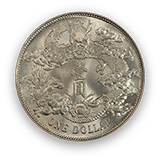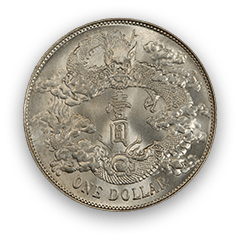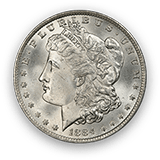Lewis Adelbert Hadley (1870-1951) 的钱币相册
The 1870 Three-Cent Nickel mimics the 1869, as both have similar mintages and nearly identical populations and grade distributions among the coins graded by PCGS. The most frequently-seen grade is MS-64, just slightly ahead of MS-63. The finest examples are fifteen at the MS66 level. Clashmarks are less frequent on this date than they are on the 1869, but the strike is equally as nice. Collectors should attempt to find examples that show as many of the vertical lines as possible on the reverse.
The 1870 Dime is a common coin, though it is not nearly as plentiful as some of the other large-mintage dates of later years. Nonetheless, it is an affordable date in most grades. The typical Mint State 1870 Dime is MS63, with MS64 a close second. Gems are available -- for a price - but none are known in MS67. Gerry Fortin, who specializes in Liberty Seated Dimes, has identified six different die pairs (actually seven, but one [F-102] appears to have been delisted). One die pair is Proof-only, another was used to strike both Proofs and Mint State examples.
At 633,900 coins, the 1870 Half Dollar has just a slightly lower mintage than the 1869-S of the previous year. However, because it was from an Eastern Mint, the 1870 Half Dollar is much more common in most grades. In Mint State, the 1870 is slightly more common than the 1869-S but usually sells for much less, making it seem like an excellent value. The initial quality of the 1870 Half Dollars was good. The luster is usually frosty, bagmarks are minimal, and the strike is strong, if not full. All in all, this is a great representative of the With Motto type.
The Carson City Mint: This institution was established by the Act of March 3, 1863, which provided also for the appointment of a superintendent at $2,000 a year and an assayer, a melter-refiner, and a coiner for $1,800 each annually. The Comstock Lode, which was discovered in June 1859, was located approximately 15 miles away and for a time was America's richest silver bonanza. In addition, large quantities of gold were extracted from the earth in the district. (While over the years the Comstock Lode has been considered primarily as a source of silver, during the existence of the Carson City Mint the total face value of gold coins struck there was approximately equal to that of silver issues.) The Carson City Mint was ready to do business in December 1869. Dies dated 1869 sent by the Philadelphia Mint were received at Carson City by October 21, 1869. How many were sent is not known; no inventory listing of 1869 and 1870 dies has been found." The 1869-dated dies were not used; the reverses were probably held for 1870 and later use. The first Carson City Mint coins were silver dollars minted from 1870-dated dies on February 10, 1870, a quantity of 3,747 pieces. All were struck using a press made in Philadelphia by Morgan & Orr (see below). Each 1870-CC dollar bore the distinctive CC mintmark on the reverse. On February 11th, Andrew Wright received the first delivery of CC dollars, a quantity of 2,300 coins. Wright, a watch-man or guard at the Mint, was undoubtedly entrusted with their safekeeping and/or paying them out. An additional three coins were saved for the Assay Commission. Others then and later were shipped by horse-drawn wagon 30 miles over very rough roads to the railhead in Reno. Stored in cloth bags, the coins were extensively marked by the time they arrived at Reno, more so at their final destinations. Production of Liberty Seated dollars at Carson City continued through early 1873, after which the new Mint Act abolished the denomination, and this branch began making trade dollars. Production of standard dollars resumed in 1878 at the Carson City Mint, using the new Morgan design, continuing through 1885, when Mint Bureau orders suspended all Carson City coinage operations. From 1889 through 1893 additional dollars were made there. In later years the Carson City Mint served as an assay office. No coins were struck after 1893. In addition to silver dollars, the Carson City Mint struck silver dimes, 20-cent pieces, quarters, half dollars, and trade dollars, as well as gold coins of the values of $5, $10, and $20. Each Carson City coin bore the distinctive CC mintmark on its reverse. Circulated grades: The 1870-CC, the first Carson City dollar issue, was minted to the extent of just 11,758. .However, quite a few were saved, probably representing specimens that were plucked from circulation after the publication of Augustus G. Heaton's Mint Marks study in 1893.























